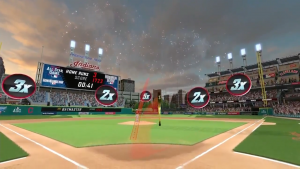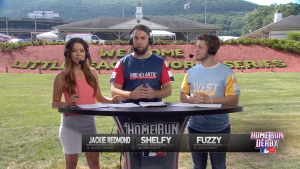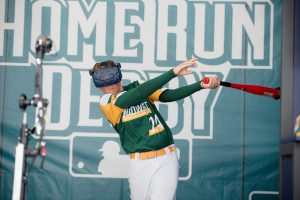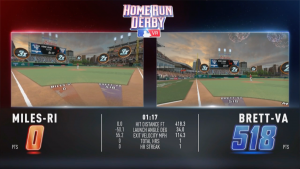Live From Little League World Series: MLB Lets Kids Go Yard With VR Home Run Derby
The competition offers a unique multiplayer esports experience
Story Highlights
Every year at the Little League World Series, an overwhelming power hitter electrifies the viewing audience. This year, it’s Mid-Atlantic’s Yadi Mateo, a 5-ft.-11 231-lb. player from Elizabeth, NJ. Whether players can clear the 225-ft. walls of Lamade or Volunteer Stadium or can’t, representatives of all 16 Little League teams joined the virtual world to hit dingers during the second consecutive Home Run Derby VR Little League Challenge.
“We have been activating our Home Derby VR videogame experience at ballparks and special events around the world and have been really pleased with fan response and engagement,” says Jamie Leece, SVP, games and VR, Major League Baseball. “This is our second year here, and the players have been great; the response from teammates, coaches, and family has been electric. It’s such a cool vibe that brings you back to your younger years and where we all built our passion for baseball: playing the game with your friends for the love of the game. That connection came right through to the VR experience and was really cool to watch.”
MORE FROM LITTLE LEAGUE WORLD SERIES
- ESPN Grows the Game With 4DReplay, Kidscast
- ESPN’s Joe Rainey on the Network’s Commitment to the Spectacle
From an Idea to a Biannual Tournament
With esports entering the mainstream, MLB wanted to get involved in this current trend. The initiative began with the league’s partnership with HTC and its HTC Vive system, which includes an HTC Vive Pro headset, a custom-made bat with an attached HTC Vive tracker, and a connection to a high-end PC.
After the groundwork was laid, the MLB team wanted to create an environment that encouraged healthy competition, evoked a feeling of physicality, and immersed the individual who participated.
“Last year, we thought it would be really cool to organize a competitive videogame contest at the All-Star Game in Washington, where the highest-scoring fans would face off bracket-style to crown a VR Home Run Derby champion,” says Leece. “The response was so positive, both in-person and viewership, that we wanted to bring it to Williamsport as part of our relationship with Little League.”
When the program’s testing was completed at the 2018 Little League World Series, the league and production partner Engine Shop took the process back to the drawing board with a litany of feedback and lessons learned.
“It was an incredible eye opener for us to see how the participants interacted both within the events and, specifically, with the HRD VR tournament,” says Jamie King, head of esports, Engine Shop. “No one walks into the batting cage alone: each person, young or old, male or female, has the support of family or teammates behind them. Witnessing their excitement, encouragement, celebration, and consolation revealed to us very important human narratives that we looked to capture coming back for a second time. And understanding the importance of family, or team, at these events can be done only by personally attending and activating at one.”
Inside the Game: Installing New Ideas, Designing a Lifelike Environment
With these new tidbits of knowledge, the project made its next appearance at this year’s event. The concept of capturing the stories behind these one-on-one battles placed an emphasis on building tension and drama near the conclusion of the competitions.

The team leveraged game-day photos and past videogame designs to construct a virtual Progressive Field.
“This year,” says King, “we made several visual changes to the in-game display to enhance viewers’ experiences when watching two competitors simultaneously, as well as to bring to life interesting statistics and data that we could display in real-time. This enabled us to create a deeper sense of drama around the authentic athletic competition taking place, both for the friends and families in person at the tournament and for the wider online audience tuning into the live stream. We also added a second replay machine in order to recap all the action of two competitors hitting home runs at the same time.”
One of the biggest elements of the contest that has raised the most eyebrows is the detailed virtual construction of the real-life location of the 2019 MLB All-Star Game, Progressive Field in Cleveland. The process is aided by experience in other forms of digital media.
“At MLB,” says Leece, “we have been developing digital products, specifically games, for several years. All of the MLB Ballparks are represented digitally in our mobile and console games, such as R.B.I. Baseball and Home Run Derby mobile.”
Furthermore, the basis of the animation is grounded by referencing a printed medium and is consistently adjusted to remain accurate.
“We are fortunate to start with game-day photos of the ballparks,” he adds. “On an annual basis, we update the digital ballparks with any physical changes the clubs might make to the structure of the park. For Progressive Field this year, we also had knowledge of how the ballpark would be dressed graphically during All-Star Week and made those adjustments to the grass, bunting, and event signage.

MLB Network’s Jackie Redmond and esports content creators RealShelfy and Fuzzy were on the mic for the live stream.
“The workflow to bring one of those assets to a 3D VR environment involves a lot of optimizations,” he continues. “The No. 1 technical challenge when building experiences in VR is frame rate. If your frame rate doesn’t stay above 60 fps — ideally, 90 fps — fans are going to have a suboptimal experience. We spend a lot of time optimizing the 3D ballparks so they can run seamlessly at a very high frame rate.”
Field of Virtual Dreams: MLB’s Efforts Let the Kids Play Without Limits
Like ESPN with the tangible field of play, the MLB put in the work that enabled an exclusive encounter unique to Williamsport. In some ways, both the MLB VR competition and ESPN’s production echo the true meaning behind the tournament: allowing young kids to enjoy the game of baseball in any capacity possible with minimal disturbance.
“We think it means something different to every player,” says Leece, “but, at its core, the opportunity to represent your town, in some cases your state and region, and ultimately your country playing the sport you love is incredibly powerful. For our event, we think it’s a nice additional reward for all the hard work the team put into making it here. It’s really about fun and playing a videogame that’s connected to your experiences in Williamsport. We really wanted to set this up as something that is enjoyed but not taken too seriously. These kids are kids, and this is a nice way of letting them have fun participating and cheering on their teammates and competitors. The intuitive sportsmanship shown by these players across the country and the world is inspiring, and that too came through during our tournament.”


